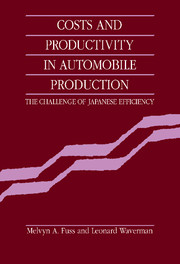Book contents
- Frontmatter
- Contents
- Preface
- Chapter 1 Introduction
- Chapter 2 International differences in output, productivity, and wages in the automobile industry: the 1950s to the mid-1980s
- Chapter 3 The cost-function approach to the analysis of cost and total factor productivity differences
- Chapter 4 Data base sources and method of construction
- Chapter 5 Empirical results: estimation of the cost function
- Chapter 6 Productivity growth in the automobile industry, 1970–1984: a comparison of the United States, Japan, Germany, and Canada
- Chapter 7 International comparisons of automobile industry cost and productivity levels: Japan, Germany, and the United States
- Chapter 8 International comparisons of automobile industry cost and productivity levels: Canadian with U.S., Japanese, and German production
- Chapter 9 Summary and conclusions
- References
- Index
Chapter 8 - International comparisons of automobile industry cost and productivity levels: Canadian with U.S., Japanese, and German production
Published online by Cambridge University Press: 16 October 2009
- Frontmatter
- Contents
- Preface
- Chapter 1 Introduction
- Chapter 2 International differences in output, productivity, and wages in the automobile industry: the 1950s to the mid-1980s
- Chapter 3 The cost-function approach to the analysis of cost and total factor productivity differences
- Chapter 4 Data base sources and method of construction
- Chapter 5 Empirical results: estimation of the cost function
- Chapter 6 Productivity growth in the automobile industry, 1970–1984: a comparison of the United States, Japan, Germany, and Canada
- Chapter 7 International comparisons of automobile industry cost and productivity levels: Japan, Germany, and the United States
- Chapter 8 International comparisons of automobile industry cost and productivity levels: Canadian with U.S., Japanese, and German production
- Chapter 9 Summary and conclusions
- References
- Index
Summary
A THE CANADA-U.S. AUTO PACT OF 1965: A COST-FUNCTION ANALYSIS OF COMPARATIVE COSTS AND EFFICIENCY IN U.S.-CANADIAN AUTOMOBILE PRODUCTION
Introduction
From its inception, the automobile industry in Canada has been protected by a combination of tariffs and domestic content provisions. These import substitution policies in the 1940s and 1950s induced U.S. multinationals to produce behind the Canadian tariff wall. The resulting Canadian auto industry was characterized by an excess number of models produced, small scale, short production runs, and high costs. There was little trade in finished automobiles across the U.S. border; in 1962, for example, 1% of cars produced in Canada were exported while 4% of cars sold in Canada came from the United States. In the late 1950s and early 1960s, this high-cost autarkic industrial structure came under increasing pressure. Because of preferential British tariffs, domestic Canadian producers were threatened by low-cost British auto imports, and Canada faced a growing deficit in its balance of payments on auto trade. As Johnson (1983) remarked, “the post-war difficulties of the Canadian industry have to be viewed in a world context, as a facet of the difficulties created for the North American industry by the development, stimulated by dollar shortage, of a strongly export-oriented European motor industry equipped with the most advanced technology and enjoying the advantage of low wages.”
In 1961, in response to these problems, the Canadian government appointed a Royal Commission on the Auto Industry (The Bladen Commission).
- Type
- Chapter
- Information
- Costs and Productivity in Automobile ProductionThe Challenge of Japanese Efficiency, pp. 166 - 212Publisher: Cambridge University PressPrint publication year: 1992



